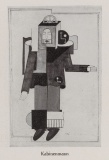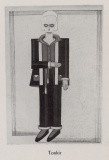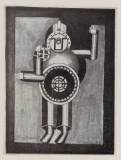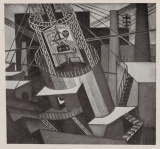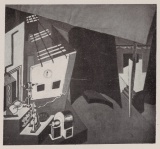Vera Idelson
Vera Idelson (Вера Идельсон, 1 December 1893, Riga - 25 August 1977, Paris) was a theatre artist and painter.
Idelson was born into a family of a petroleum engineer. She studied art, scenography and internal design in St. Petersburg and Baku and some of her first work was influenced by Russian folk motives. When she moved to Moscow she became familiar with innovators of theatrical styles and met artists such as Alexander Tairov, Vsevolod Meyerhold and Alexandra Ekster. Majority of Idelson’s paintings were done in Cubo-futurist style, but she also decorated fabrics, did embroidery and pottery.
In 1922 she immigrated to Berlin and there took part in the First Russian Art Exhibition at the Van Diemen gallery. She was a close friend of the playwright Ruggero Vasari, director of the futurist gallery, who she met whilst in Berlin.
In 1924, whilst in Capri she visited a group of futurists that surrounded Filippo Marinetti and made decorations for a futuristic play at the Marconi Hall. In the same year, she headed a project for set designs for futuristic plays by Vasari.
In 1926 she took courses organised by Aleksandra Ekster in Paris and together with Ekster took part in the International Theatre exhibition in New York.
In 1927 Idelson created constructivist puppets for a Parisienne version of the L’angoisse des machines by Vasari, and together with the set designer Enrico Prampolini decorated the Futuristic Pantomimes at the Théatre des Champs-Elysées.
During the 1930s she was a member of the Circle and Square art group, exhibited at the Salon d’Automne and wrote articles about modern theatre. In 1936 she created costumes for the 14 juillet opera, based on a Romain Rolland libretto; and in 1937 created costumes for the Les bacchantes, based on a play by Euripides. [1]
Works[edit]
- Costume design for Maschinenangst by Ruggero Vasari
From Der Sturm, January 1925. [2]
